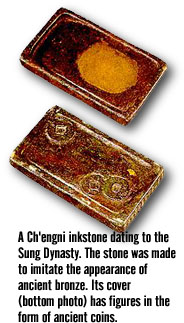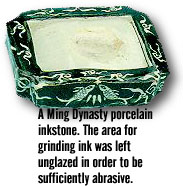Abrasive
Treasure (page 3)
Photos Courtesy of The National
Palace Mesuem
The Ch'engni inkstone (¡q¼áªdµx) is considered
the best of all the ceramic types. Gaining popularity during the T'ang
Dynasty (618-907), it was by far the most difficult of all inkstones, ceramic
or otherwise, to manufacture. According to historical records, first a
cloth bag was suspended in a running stream.  After
approximately one year, the bag was removed from the water, by which time
fme silt had gathered in the bag. Small rocks and other impurities were
then filtered out, and the remaining silt dried in the sun. It was next
mixed with huang tan t'uan ( ¶À¤¦¹Î), a resinous plant substance, and kneaded
together. After being shaped in a mold and decorated with a knife, it was
removed from the mold, placed in a bag containing rice husks and cow manure,
and hung in a dark, cool place to dry. It was later fired in a ceramic
kiln for approximately ten days. After cooling, it was covered with black
wax, submerged in a vat of rice vinegar, and finally steamed over high
heat about a half dozen times.
After
approximately one year, the bag was removed from the water, by which time
fme silt had gathered in the bag. Small rocks and other impurities were
then filtered out, and the remaining silt dried in the sun. It was next
mixed with huang tan t'uan ( ¶À¤¦¹Î), a resinous plant substance, and kneaded
together. After being shaped in a mold and decorated with a knife, it was
removed from the mold, placed in a bag containing rice husks and cow manure,
and hung in a dark, cool place to dry. It was later fired in a ceramic
kiln for approximately ten days. After cooling, it was covered with black
wax, submerged in a vat of rice vinegar, and finally steamed over high
heat about a half dozen times.
The color of the finished inkstone depended on the area of production
and other variables such as the temperature of the kiln. If the last couple
of production steps sound like a page from the Chinese culinary arts, then
the names given to the different colors of inkstones are off the menu of
a seafood restaurant. These include, among others, "shrimp head red,"
"crab shell blue," "eel orange," and ''fish stomach
white." The final appearance of the Ch'engni inkstone was very similar
to that of stone, and supposedly equally as hard. It had a metallic sound
to it when struck, and even a steel knife could not scratch its surface.
Although these inkstones were highly regarded at the time, difficulty of
production was no doubt partially responsible for their growing scarcity
after the T'ang Dynasty.
By the Sung Dynasty (960-1279), inkstones once more started to be made
almost exclusively of stone. This reflect- ed the mature artistic expression
of the Sung period, where the emphasis was no longer on complexity of manufacture,
but on the simple and refined beauty of natural stone. The preference has
en- dured up to the present day.
Clearly, not just any stone could be used to make an inkstone because
of aes- thetic and practical considerations. Ac- cording to the History
of the Inkstone written by Mi Fei (¦Ìªè ), the Sung schol- ar, calligrapher,
and fanatic collector of inkstones, stones from thirteen different regions
of China were used in the manu- facture  of
inkstones. In addition, ink- stones were embellished with carving, both
with designs and calligraphy. Elevated from the status of utilitarian items,
good inkstones were cherished as works of art in themselves. It was during
the Sung that the inkstone, along with brush, inkstick, and paper, was
given the accolade of the "four treasures of the scholar's study."
of
inkstones. In addition, ink- stones were embellished with carving, both
with designs and calligraphy. Elevated from the status of utilitarian items,
good inkstones were cherished as works of art in themselves. It was during
the Sung that the inkstone, along with brush, inkstick, and paper, was
given the accolade of the "four treasures of the scholar's study."
Not all stones are created equal, and of all the areas which produced
inkstones during the Sung, three were considered to be the best: those
from Tuanchou ( ºÝ¦{), Hsichou (¾ù¦{), and Ch'ingchou ( «C¦{). Before long,
stones from Ch'ing- chou were unobtainable, and those from Yaoho (¬«¦{)
were considered equally valuable. Together with the Ch'engni inkstone,
which was still produced in limited numbers during the Sung, the four were
crowned as China's most famous inkstones. Today, a millennium later, these
are still considered the best by antique collectors. Moreover, the ink-
stones from the area formerly known as Tuanchou and Hsichou are still being
produced by contemporary craftsmen.


Foreword and Preface
The Brush: Unaltered Craftsmanship
The Inkstick: Black Soil
Artistry
Paper: The Basic Fiber of Communication
The Inkstone: Abrasive
Treausre
The Inkstone: Unparalleled
Connaisseur
Accessories For The Studio:
Functional Artistry
for questions and comments please send to liaoless@iii.org.tw

By Jeffrey H. Mindich
Published by the Council for Cultureal Affairs Executive Yuan Republic
of China
 After
approximately one year, the bag was removed from the water, by which time
fme silt had gathered in the bag. Small rocks and other impurities were
then filtered out, and the remaining silt dried in the sun. It was next
mixed with huang tan t'uan ( ¶À¤¦¹Î), a resinous plant substance, and kneaded
together. After being shaped in a mold and decorated with a knife, it was
removed from the mold, placed in a bag containing rice husks and cow manure,
and hung in a dark, cool place to dry. It was later fired in a ceramic
kiln for approximately ten days. After cooling, it was covered with black
wax, submerged in a vat of rice vinegar, and finally steamed over high
heat about a half dozen times.
After
approximately one year, the bag was removed from the water, by which time
fme silt had gathered in the bag. Small rocks and other impurities were
then filtered out, and the remaining silt dried in the sun. It was next
mixed with huang tan t'uan ( ¶À¤¦¹Î), a resinous plant substance, and kneaded
together. After being shaped in a mold and decorated with a knife, it was
removed from the mold, placed in a bag containing rice husks and cow manure,
and hung in a dark, cool place to dry. It was later fired in a ceramic
kiln for approximately ten days. After cooling, it was covered with black
wax, submerged in a vat of rice vinegar, and finally steamed over high
heat about a half dozen times. 
 of
inkstones. In addition, ink- stones were embellished with carving, both
with designs and calligraphy. Elevated from the status of utilitarian items,
good inkstones were cherished as works of art in themselves. It was during
the Sung that the inkstone, along with brush, inkstick, and paper, was
given the accolade of the "four treasures of the scholar's study."
of
inkstones. In addition, ink- stones were embellished with carving, both
with designs and calligraphy. Elevated from the status of utilitarian items,
good inkstones were cherished as works of art in themselves. It was during
the Sung that the inkstone, along with brush, inkstick, and paper, was
given the accolade of the "four treasures of the scholar's study."